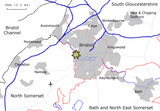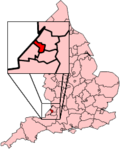Clifton Suspension Bridge
2007 Schools Wikipedia Selection. Related subjects: Architecture; Engineering
 Clifton suspension bridge taken from a slip road off Brunel Way. |
|
| Carries | Cars, pedestrians and cycles |
|---|---|
| Crosses | River Avon |
| Locale | Bristol |
| Maintained by | Clifton Suspension Bridge Trust |
| Design | Suspension |
| Longest span | 702 ft (214 m) |
| Total length | 1,352 ft (414 m) |
| Width | 31 ft (9.5m) |
| Clearance below | 245 ft (75 m) above high water level |
| Opening date | 1864 |
| Toll | 30 pence |
| Coordinates | ( grid reference ST564730) |
 Shown within Bristol (above) and England.
|
 |
The Clifton Suspension Bridge is a suspension bridge, spanning the Avon Gorge and linking Clifton in Bristol to Leigh Woods in North Somerset, UK. Designed by Isambard Kingdom Brunel, it is a distinctive landmark that is often used as a symbol of Bristol. It is a grade I listed building.
The bridge has long had a reputation as a suicide spot. Because of this, dedicated telephones with a direct line to The Samaritans were placed beside the bridge. However, the phones have since been vandalised and there are now only wires dangling from where the phones once hung. In 1885, a 22 year old woman called Sarah Ann Henley survived a jump from the bridge when her billowing skirts acted as a parachute, and subsequently lived into her eighties.
History
The idea of building a bridge across the Avon Gorge originated in 1754, with a bequest in the will of Bristolian merchant William Vick, who left £1,000 invested with instructions that when the interest had accumulated to £10,000, it should be used for the purpose of building a stone bridge between Clifton Down (which was in Gloucestershire, outside the City of Bristol, until the 1830s) and Leigh Woods (then in Somerset), both of which were barely populated at the time.
By the 1820s, Vick's bequest was nearing £8,000, but it was estimated that a stone bridge would cost over ten times that amount. An Act of Parliament was passed to allow a wrought-iron suspension bridge to be built instead, and tolls levied to recoup the cost. In 1829, a competition was held to find a design for the bridge; the judge, Thomas Telford, rejected all designs, and tried to insist on a hugely expensive design of his own. A second competition, held with new judges, was won by Brunel's design, for a suspension bridge with fashionably Egyptian-influenced towers.
An attempt to build Brunel's design in 1831 was stopped by the Bristol Riots, which severely dented commercial confidence in Bristol. Work was not started again until 1836, and thereafter the capital from Vick's bequest and subsequent investment proved woefully inadequate. By 1843, the towers had been built in unfinished stone, but funds were exhausted. In 1851, the ironwork was sold and used to build the Brunel-designed Royal Albert Bridge on the railway between Plymouth and Saltash.
Brunel died in 1859, without seeing the completion of the bridge. Brunel's colleagues in the Institution of Civil Engineers felt that completion of the Bridge would be a fitting memorial, and started to raise new funds. In 1860, Brunel's Hungerford suspension bridge, over the Thames in London, was demolished to make way for a new railway bridge to Charing Cross railway station, and its chains were purchased for use at Clifton. A slightly revised design was made by William Henry Barlow and Sir John Hawkshaw; it has a wider, higher and sturdier deck than Brunel intended, triple chains instead of double, and the towers were left as rough stone rather than being finished in Egyptian style. Work on the bridge was restarted in 1862, and was complete by 1864. The bridge has been open continuously since then.
The bridge is now managed by a trust set up by Act of Parliament in 1952. Tolls are levied on vehicles but no longer on cyclists or pedestrians. The bridge is usually illuminated at night, with a modernised, LED-based array switched on for the first time on 8 April 2006, to an accompaniment of fireworks and festivities. This was after an extended period of much reduced lighting, and timed to coincide with the bicentenary of Brunel's birth.
On 26 November 2003, the last ever Concorde flight (Concorde 216) flew over the bridge before landing at Filton Airfield. It was a symbolic moment which commemorated Bristol's past feats in engineering.
In 2002 it was discovered that the large red sandstone abutment on the Leigh Woods side is not (as had been thought for many years) solid stone, but has twelve vaulted chambers up to 35 ft (11 m) high within it. In 2003 the weight of crowds returning from the Ashton Court festival and Bristol International Balloon Fiesta put such great strain on the bridge that it was decided to close the bridge to all traffic, including pedestrians, during the whole of the Ashton Court Festival and part of the Balloon Fiesta in 2004.
Dimensions
- Span: 702 ft (214 m)
- Height of towers: 86 ft (26 m)
- Clearance: 245 ft (75 m) above high water level
- Traffic: Four million vehicles per year


